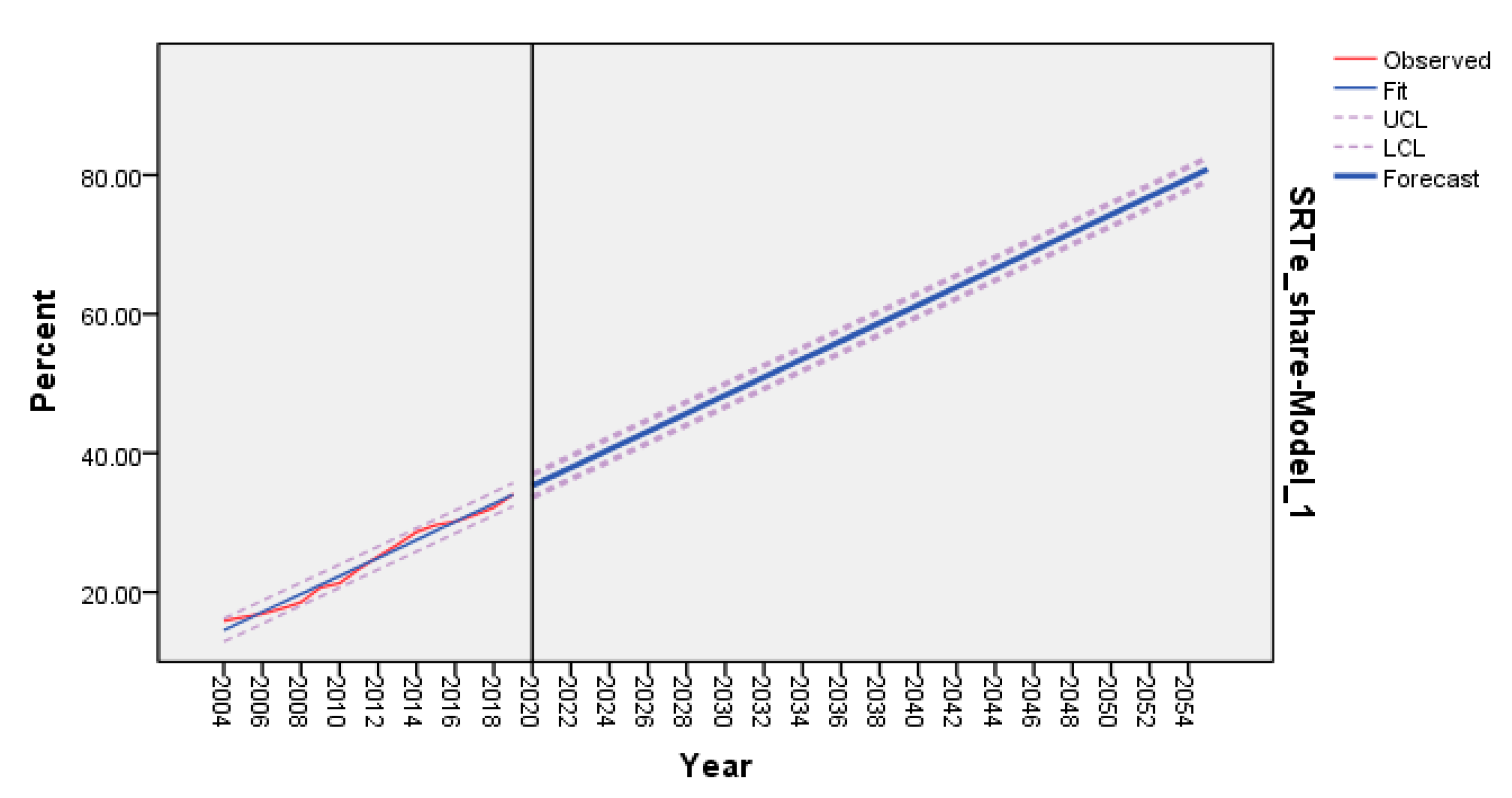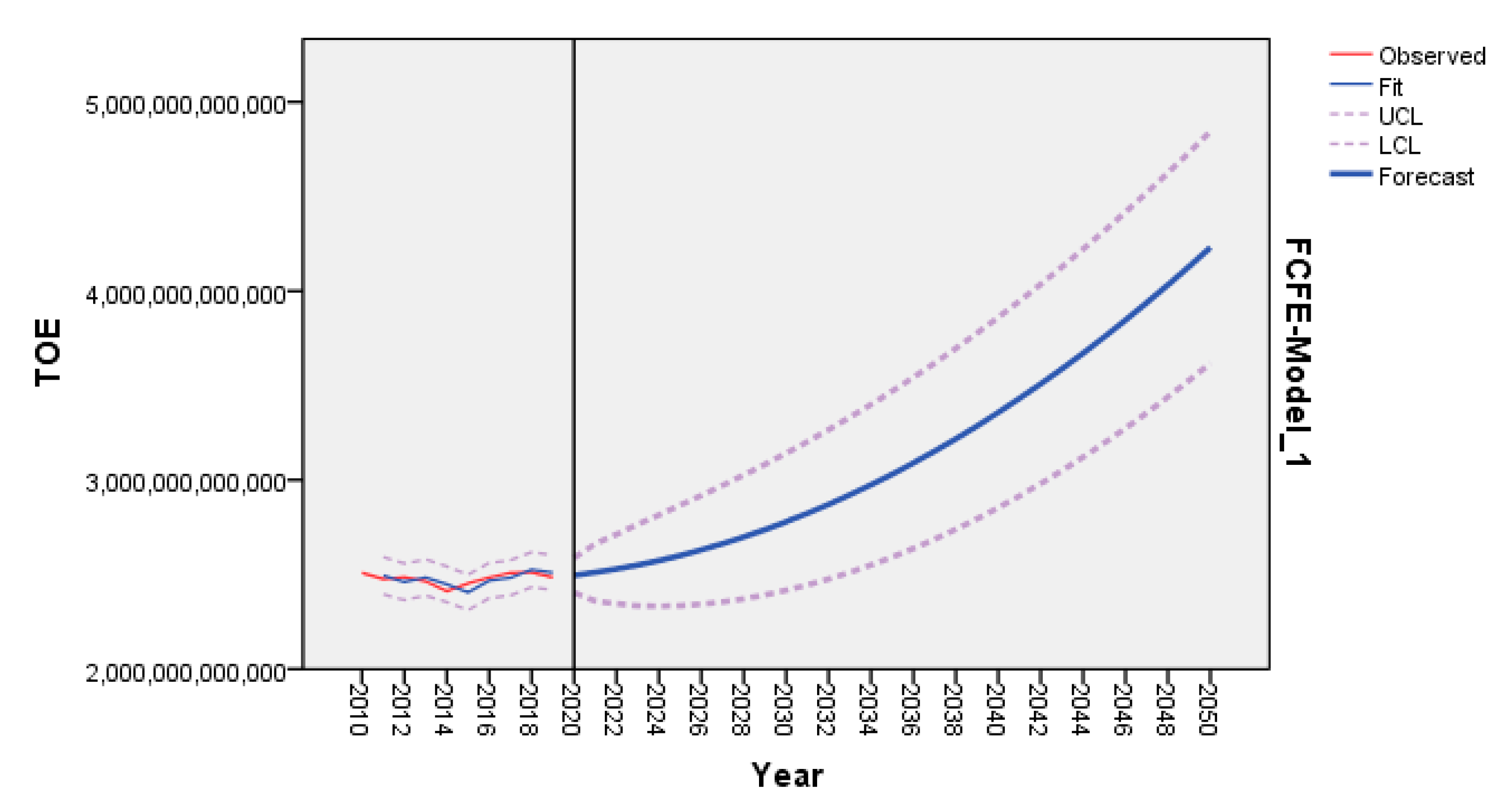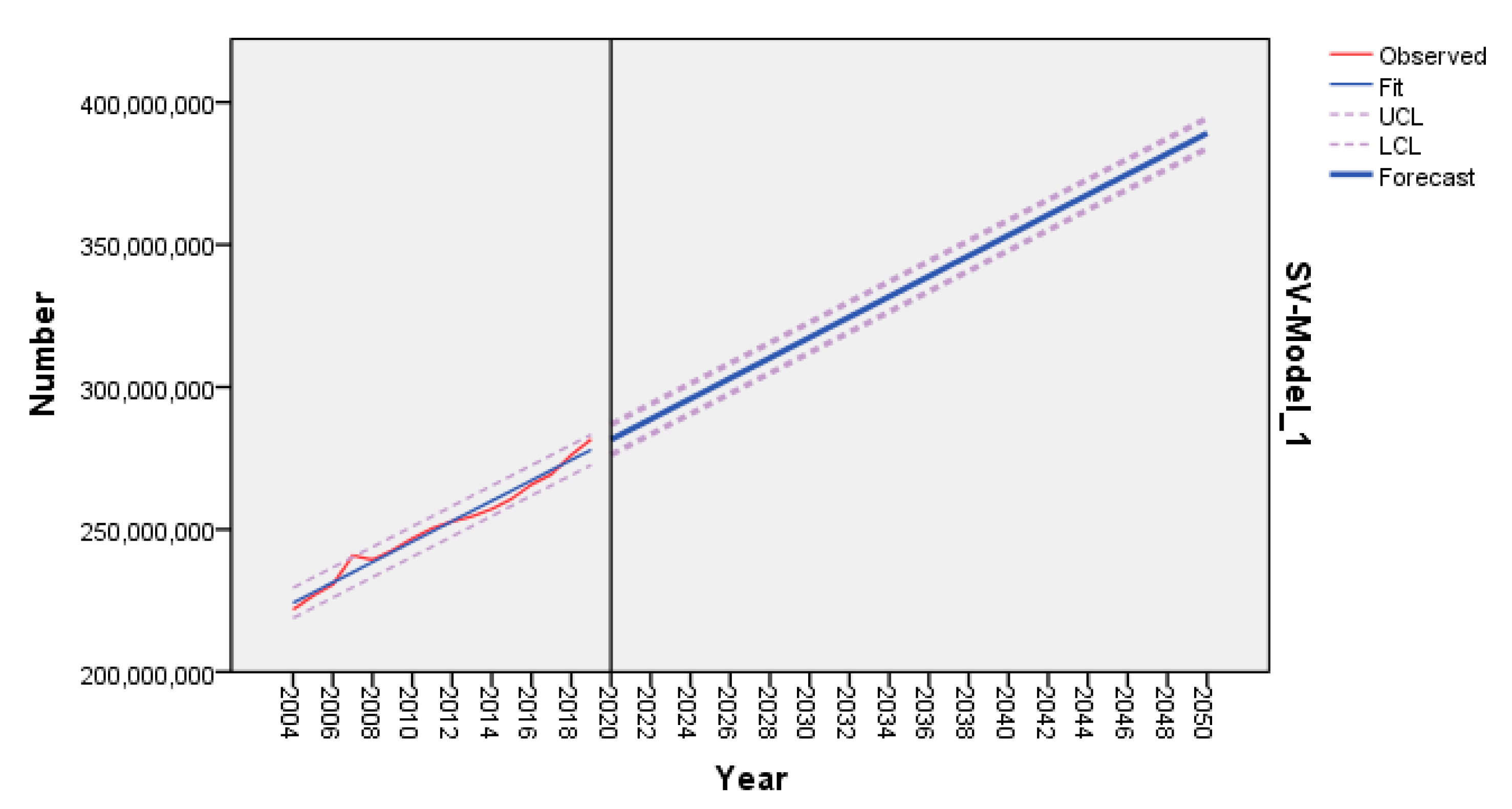Efficient Management of Power Losses from Renewable Sources Using Removable E.V. Batteries
Abstract
:1. Introduction
2. Literature Review
2.1. Relationship between Variable Renewable Energy and Storage Requirements
2.2. Policies and Models for Electric Vehicles
2.3. Integrated Electricity Storage and Supply System
3. Materials and Methods
3.1. Selected Variable
3.2. Research Hypothesis
3.3. Research Methods
4. Results
5. Discussion
6. Conclusions
Author Contributions
Funding
Institutional Review Board Statement
Informed Consent Statement
Data Availability Statement
Conflicts of Interest
Appendix A
| Year | FCFE (toe) | FCFE (kwh) | SRTe Share (%) | SRTe (kwh) | SRTen (kwh) | SV (Number) |
|---|---|---|---|---|---|---|
| 2010 | 215,697,928 | 2,508,566,902,640 | 21.3 | 534,324,750,262 | 228,996,321,541 | 246,780,541 |
| 2011 | 212,912,820 | 2,476,176,096,600 | 23.32 | 577,444,265,727 | 247,476,113,883 | 250,392,058 |
| 2012 | 213,722,093 | 2,485,587,941,590 | 25.15 | 625,125,367,310 | 267,910,871,704 | 252,759,003 |
| 2013 | 211,895,445 | 2,464,344,025,350 | 26.85 | 661,676,370,806 | 283,575,587,488 | 254,593,235 |
| 2014 | 207,395,462 | 2,412,009,223,060 | 28.68 | 691,764,245,174 | 296,470,390,789 | 257,176,539 |
| 2015 | 210,895,273 | 2,452,712,024,990 | 29.66 | 727,474,386,612 | 311,774,737,119 | 260,787,022 |
| 2016 | 213,621,435 | 2,484,417,289,050 | 30.16 | 749,300,254,377 | 321,128,680,447 | 265,787,532 |
| 2017 | 215,740,619 | 2,509,063,398,970 | 31.09 | 780,067,810,740 | 334,314,776,031 | 269,370,978 |
| 2018 | 215,972,931 | 2,511,765,187,530 | 32.18 | 808,286,037,347 | 346,408,301,720 | 276,127,390 |
| 2019 | 213,650,672 | 2,484,757,315,360 | 34.08 | 846,805,293,075 | 362,916,554,175 | 281,677,483 |
| Year | FCFE (kwh) | SRTe Share (%) | SRTe (kwh) | SRTen (kwh) | SEV (Number) | SV (Number) |
|---|---|---|---|---|---|---|
| 2020 | 2,495,754,808,360 | 35.33 | 881,750,173,794 | 377,892,931,626 | 157,455,388 | 281,572,610 |
| 2021 | 2,511,413,464,277 | 36.62 | 919,679,610,618 | 394,148,404,551 | 164,228,502 | 285,157,790 |
| 2022 | 2,528,970,622,354 | 37.92 | 958,985,659,997 | 410,993,854,284 | 171,247,439 | 288,742,971 |
| 2023 | 2,550,133,479,267 | 39.22 | 1,000,162,350,569 | 428,641,007,387 | 178,600,420 | 292,328,151 |
| 2024 | 2,573,847,066,366 | 40.52 | 1,042,922,831,292 | 446,966,927,696 | 186,236,220 | 295,913,331 |
| 2025 | 2,600,763,305,522 | 41.82 | 1,087,639,214,369 | 466,131,091,873 | 194,221,288 | 299,498,511 |
| 2026 | 2,630,479,339,146 | 43.12 | 1,134,262,691,040 | 486,112,581,874 | 202,546,909 | 303,083,692 |
| 2027 | 2,663,244,114,612 | 44.42 | 1,183,013,035,711 | 507,005,586,733 | 211,252,328 | 306,668,872 |
| 2028 | 2,698,903,793,947 | 45.72 | 1,233,938,814,593 | 528,830,920,540 | 220,346,217 | 310,254,052 |
| 2029 | 2,737,553,441,909 | 47.02 | 1,287,197,628,386 | 551,656,126,451 | 229,856,719 | 313,839,232 |
| 2030 | 2,779,134,312,870 | 48.32 | 1,342,877,699,979 | 575,519,014,277 | 239,799,589 | 317,424,412 |
| 2031 | 2,823,682,708,914 | 49.62 | 1,401,111,360,163 | 600,476,297,213 | 250,198,457 | 321,009,593 |
| 2032 | 2,871,176,197,031 | 50.92 | 1,462,002,919,528 | 626,572,679,798 | 261,071,950 | 324,594,773 |
| 2033 | 2,921,628,639,784 | 52.22 | 1,525,674,475,695 | 653,860,489,584 | 272,441,871 | 328,179,953 |
| 2034 | 2,975,031,470,750 | 53.52 | 1,592,236,843,145 | 682,387,218,491 | 284,328,008 | 331765133 |
| 2035 | 3,031,389,983,582 | 54.82 | 1,661,807,989,000 | 712,203,423,857 | 296,751,427 | 335,350,314 |
| 2036 | 3,090,700,907,047 | 56.12 | 1,734,501,349,035 | 743,357,721,015 | 309,732,384 | 338,935,494 |
| 2037 | 3,152,966,262,617 | 57.42 | 1,810,433,227,995 | 775,899,954,855 | 323,291,648 | 342,520,674 |
| 2038 | 3,218,184,801,115 | 58.72 | 1,889,718,115,215 | 809,879,192,235 | 337,449,663 | 346,105,854 |
| 2039 | 3,286,357,294,474 | 60.02 | 1,972,471,648,143 | 845,344,992,061 | 352,227,080 | 349,691,035 |
| 2040 | 3,357,483,265,676 | 61.32 | 2,058,808,738,513 | 882,346,602,220 | 367,644,418 | 353,276,215 |
| 2041 | 3,431,563,009,496 | 62.62 | 2,148,844,756,546 | 920,933,467,091 | 383,722,278 | 356,861,395 |
| 2042 | 3,508,596,343,776 | 63.91 | 2,242,343,923,307 | 961,004,538,560 | 400,418,558 | 360,446,575 |
| 2043 | 3,588,583,381,082 | 65.21 | 2,340,115,222,804 | 1,002,906,524,059 | 417,877,718 | 364,031,755 |
| 2044 | 3,671,524,051,853 | 66.51 | 2,441,930,646,887 | 1,046,541,705,809 | 436,059,044 | 367,616,936 |
| 2045 | 3,757,418,399,074 | 67.81 | 2,547,905,416,412 | 1,091,959,464,177 | 454,983,110 | 371,202,116 |
| 2046 | 3,846,266,396,183 | 69.11 | 2,658,154,706,402 | 1,139,209,159,887 | 474,670,483 | 374,787,296 |
| 2047 | 3,938,068,059,594 | 70.41 | 2,772,793,720,760 | 1,188,340,166,040 | 495,141,736 | 378,372,476 |
| 2048 | 4,032,823,379,164 | 71.71 | 2,891,937,645,199 | 1,239,401,847,942 | 516,417,437 | 381,957,657 |
| 2049 | 4,130,532,361,161 | 73.01 | 3,015,701,676,884 | 1,292,443,575,807 | 538,518,157 | 385,542,837 |
| 2050 | 4,231,195,001,711 | 74.31 | 3,144,201,005,771 | 1,347,514,716,759 | 561,464,465 | 389,128,017 |
References
- EVUE. Electric Vehicle in Urban Europe. 2012. Available online: https://urbact.eu/file/2015/download?token=lnO3HY-H (accessed on 5 June 2021).
- Mohammad, A.; Zamora, R.; Lie, T.T. Integration of Electric Vehicles in the Distribution Network: A Review of P.V. Based Electric Vehicle Modelling. Energies 2020, 13, 4541. [Google Scholar] [CrossRef]
- Braun, M.; Büdenbender, K.; Magnor, D.; Jossen, A. Photovoltaic Self-Consumption in Germany Using Lithium-Ion Storage to Increase Self-Consumed Photovoltaic Energy. In The Compiled State-of-the-Art of P.V. Solar Technology and Deployment, Proceedings of the 24th European Photovoltaic Solar Energy Conference and Exhibition, Hamburg, Germany, 21–25 September 2009; Sinke, W., Ed.; EU PVSEC: Munich, Germany, 2009. [Google Scholar]
- Bost, M.; Hirschl, B.; Aretz, A. Effekte von Eigenverbrauch und Netzparität bei der Photovoltaik: Beginn der Dezentralen Energierevolution oder Nischeneffekt; Greenpeace Energy eG: Berlin/Hamburg, Germany, 2011. [Google Scholar]
- Colmenar-Santos, A.; Campiñez-Romero, S.; Pérez-Molina, C.; Castro-Gil, M. Profitability analysis of grid-connected photovoltaic facilities for household electricity self-sufficiency. Energy Policy 2012, 51, 749–764. [Google Scholar] [CrossRef]
- Perez-Arriaga, I.; Batlle, C. Impacts of intermittent renewables on electricity generation system operation. Econ. Energy Environ. Policy 2012, 1, 3–17. [Google Scholar] [CrossRef] [Green Version]
- Brown, T.W.; Bischof-Niemz, T.; Blok, K.; Breyer, C.; Lund, H.; Mathiesen, B.V. Response to ‘Burden of proof: A comprehensive review of the feasibility of 100% renewable-electricity systems’. Renew. Sustain. Energy Rev. 2018, 92, 834–847. [Google Scholar] [CrossRef]
- Sinn, H.-W. Buffering volatility: A study on the limits of Germany’s energy revolution. Eur. Econ. Rev. 2017, 99, 130–150. [Google Scholar] [CrossRef]
- Zerrahn, A.; Schilla, W.-P.; Kemferta, C. On the economics of electrical storage for variable renewable energy sources. Eur. Econ. Rev. 2018, 108, 259–279. [Google Scholar] [CrossRef]
- Pfenninger, S.; Hawkes, A.; Keirstead, J. Energy systems modeling for twenty-first-century energy challenges. Renew. Sustain. Energy Rev. 2014, 33, 74–86. [Google Scholar] [CrossRef]
- Pfenninger, S. Energy scientists must show their workings. Nature 2017, 542, 393. [Google Scholar] [CrossRef]
- Blanco, H.; Faaij, A. A review at the role of storage in energy systems with a focus on power to gas and long-term storage. Renew. Sustain. Energy Rev. 2018, 81, 1049–1086. [Google Scholar] [CrossRef]
- Zerrahn, A.; Schill, W.-P. Long-run power storage requirements for high shares of renewables: Review and a new model. Renew. Sustain. Energy Rev. 2017, 79, 1518–1534. [Google Scholar] [CrossRef]
- Schill, W.-P.; Zerrahn, A. Long-Run power storage requirements for high shares of renewables: Results and sensitivities. Renew. Sustain. Energy Rev. 2018, 83, 156–171. [Google Scholar] [CrossRef]
- Scholz, Y.; Gils, H.C.; Pietzcker, R.C. Application of a high-detail energy system model to derive power sector characteristics at high wind and solar shares. Energy Econ. 2017, 64, 568–582. [Google Scholar] [CrossRef] [Green Version]
- Cebulla, F.; Naegler, T.; Pohl, M. Electrical energy storage in highly renewable European energy systems: Capacity requirements, spatial distribution, and storage dispatch. J. Energy Storage 2017, 14, 211–223. [Google Scholar] [CrossRef] [Green Version]
- Denholm, P.; Hand, M. Grid flexibility and storage required to achieve very high penetration of variable renewable electricity. Energy Policy 2011, 39, 1817–1830. [Google Scholar] [CrossRef]
- Budischak, C.; Sewell, D.; Thomson, H.; Mach, L.; Veron, D.E.; Kempton, W. Cost-Minimized combinations of wind power, solar power and electro-chemical storage, powering the grid up to 99.9% of the time. J. Power Sources 2013, 225, 60–74. [Google Scholar] [CrossRef] [Green Version]
- Jacobson, M.Z.; Delucchi, M.A.; Cameron, M.A.; Frew, B.A. Low-Cost solution to the grid reliability problem with 100% penetration of intermittent wind, water, and solar for all purposes. Proc. Natl. Acad. Sci. USA 2015, 112, 15060–15065. [Google Scholar] [CrossRef] [Green Version]
- MacDonald, A.E.; Clack, C.T.M.; Alexander, A.; Dunbar, A.; Wilczak, J.; Xie, Y. Future cost-competitive electricity systems and their impact on U.S. CO emissions. Nat. Clim. Chang. 2016, 6, 526–531. [Google Scholar] [CrossRef]
- de Sisternes, F.J.; Jenkins, J.D.; Botterud, A. The value of energy storage in decarbonizing the electricity sector. Appl. Energy 2016, 175, 368–379. [Google Scholar] [CrossRef] [Green Version]
- Denholm, P.; Mai, T. Timescales of Energy Storage Needed for Reducing Renewable Energy Curtailment; Technical Report; National Renewable Energy Laboratory: Golden, CO, USA, 2017; Available online: https://www.nrel.gov/docs/fy17osti/68960.pdf (accessed on 12 June 2021).
- Fürsch, M.; Hagspiel, S.; Jägemann, C.; Nagl, S.; Lindenberger, D.; Tröster, E. The role of grid extensions in a cost-efficient transformation of the European electricity system until 2050. Appl. Energy 2013, 104, 642–652. [Google Scholar] [CrossRef] [Green Version]
- Haller, M.; Ludig, S.; Bauer, N. Decarbonization scenarios for the E.U. and MENA power system: Considering spatial distribution and short term dynamics of renewable generation. Energy Policy 2012, 36, 149–184. [Google Scholar] [CrossRef]
- Lund, P.D.; Lindgren, J.; Mikkola, J.; Salpakari, J. Review of energy system flexibility measures to enable high levels of variable renewable electricity. Renew. Sustain. Energy Rev. 2015, 45, 785–807. [Google Scholar] [CrossRef] [Green Version]
- Lisin, A.; Senjyu, T. Renewable Energy Transition: Evidence from Spillover Effects in Exchange-Traded Funds. Int. J. Energy Econ. Policy 2021, 11, 1–6. [Google Scholar] [CrossRef]
- Lisin, A. Prospects and Challenges of Energy Cooperation between Russia and South Korea. Int. J. Energy Econ. Policy 2020, 10, 130–135. [Google Scholar] [CrossRef]
- van de Vegte, H. Overview of Potential Locations for New Pumped Storage Plants in EU 15, Switzerland and Norway. Deliverable D4.2 Final Report of the Research Project eSTORAGE within the Seventh EU Framework Programme. 2015. Available online: http://www.estorage-project.eu/wp-content/uploads/2013/06/eStorage_D4.2-Overview-of-potential-locations-for-new-variable-PSP-in-Europe.pdf (accessed on 12 February 2018).
- Yang, S.X.; Zhang, D.; Fu, J.; Fan, S.; Ji, Y. Market cultivation of electric vehicles in China: Survey based on consumer behavior. Sustainability 2018, 10, 4056. [Google Scholar] [CrossRef] [Green Version]
- Boyle, G. Renewable Energy: Power for a Sustainable Future, 3rd ed.; Oxford University Press: Oxford, UK, 2012. [Google Scholar]
- Cho, Y.; Blommestein, K.V. Investigating the Adoption of Electric Vehicles Using Agent-based Model. In Proceedings of the 2015 Portland International Conference Management Engineering Technology, Portland, OR, USA, 2–6 August 2015; pp. 2337–2345. [Google Scholar]
- Mersky, A.C.; Sprei, F.; Samaras, C.; Qian, Z.S. Effectiveness of incentives on electric vehicle adoption in Norway. Transp. Res. Part D Transp. Environ. 2016, 46, 56–68. [Google Scholar] [CrossRef] [Green Version]
- Longo, M.; Zaninelli, D.; Viola, F.; Romano, P.; Miceli, R. How Is the Spread of the Electric Vehicles? In Proceedings of the 2015 IEEE 1st International Forum on Research and Technologies for Society and Industry Leveraging a Better Tomorrow (RTSI), Turin, Italy, 16–18 September 2015; pp. 439–445. [Google Scholar] [CrossRef]
- Wang, E.Q. Research on Business Mode and Planning of E.V.’s Charging Facilities. Master’s Thesis, North China Electric Power University, Beijing, China, 2012. [Google Scholar]
- Zhang, X.R. Research on policy promotion mechanism optimization of technological innovation in electric vehicle industry. Manag. Adm. 2019, 5, 88–92. [Google Scholar]
- Gong, L.Y. Study on New Energy Vehicles Application Strategies in Transportation Industry. In Proceedings of the 2016 2nd International Conference on Energy Equipment Science and Engineering, Guangzhou, China, 12–14 November 2016. [Google Scholar]
- Vander Steen, M.; Van Schelven, R.; Kotter, R.; Van Twist, M.; Peter van Deventer, M.E.V. Policy compared: An international comparison of governments policy strategy towards e-mobility. In E-Mobility in Europe; Springer: Berlin/Heidelberg, Germany, 2015; pp. 27–53. [Google Scholar]
- Mishina, V.Y.; Khomyakova, L.I. Dedollarization and settlements in national currencies: Eurasian and Latin American experience. Vopr. Ekon. 2020, 9, 61–79. [Google Scholar] [CrossRef]
- Mikhaylov, A. Development of Friedrich von Hayek’s theory of private money and economic implications for digital currencies. Terra Econ. 2021, 19, 53–62. [Google Scholar] [CrossRef]
- Mikhaylov, A. Cryptocurrency Market Analysis from the Open Innovation Perspective. J. Open Innov. Technol. Mark. Complex. 2020, 6, 197. [Google Scholar] [CrossRef]
- Harrysson, S.; Ulmefors, M.; Kazlova, A. Overview and Analysis of Electric Vehicle Incentives Applied across Eight Selected Country Markets; Technical Report; Blekinge Institute of Technology, The Department for Strategic Sustainable Development: Blekinge, Sweden, 2015. [Google Scholar]
- Bocken, N.M.P.; Short, S.W.; Rana, P.; Evans, S. A literature and practice review to develop sustainable business model archetypes. J. Clean. Prod. 2014, 65, 42–56. [Google Scholar] [CrossRef] [Green Version]
- Wang, Y.; Jin, L.; Xiao, K.; Jia, H.G.; Li, Z.H. The Government Subsidy Research of New Energy Sedan Industry Based on the Consumer Demand. Adv. Mater. Res. 2013, 711, 446–451. [Google Scholar] [CrossRef]
- Cheyunwang. How to Turn Better Place into a Dead End. Available online: http://www.cheyun.com/content/1837 (accessed on 18 June 2019).
- Luntan. The Failure of Better Place and Tesla. Available online: http://club.autohome.com.cn/bbs/thread/9263471c0eda58fc/73669881-1.html (accessed on 20 June 2019).
- Shepero, M.; Munkhammar, J.; Widen, J.; Bishop, J.D.; Boström, T. Modeling of photovoltaic power generation and electric vehicles charging on city-scale: A review. Renew. Sustain. Energy Rev. 2018, 89, 61–71. [Google Scholar] [CrossRef] [Green Version]
- Pasaoglu, G.; Fiorello, D.; Martino, A.; Zani, L.; Zubaryeva, A.; Thiel, C. Travel patterns and the potential use of electric cars—Results from a direct survey in six European countries. Technol. Forecast. Soc. Chang. 2014, 87, 51–59. [Google Scholar] [CrossRef]
- Jordehi, A.R. Optimisation of demand response in electric power systems, a review. Renew. Sustain. Energy Rev. 2019, 103, 308–319. [Google Scholar] [CrossRef]
- Strbac, G. Demand side management: Benefits and challenges. Energy Policy 2008, 36, 4419–4426. [Google Scholar] [CrossRef]
- Kempton, W.; Letendre, S. Electric vehicles as a new power source for electric utilities. Transp. Res. Part D Transp. Environ. 1997, 2, 157–175. [Google Scholar] [CrossRef]
- Eurostat, 1. Final Energy Consumption by Product. Electricity. Available online: https://appsso.eurostat.ec.europa.eu/nui/submitViewTableAction.do (accessed on 15 June 2021).
- Eurostat, 2. Share of Renewable Energy in Gross Final Energy Consumption by Sector. Electricity. Available online: https://appsso.eurostat.ec.europa.eu/nui/submitViewTableAction.do (accessed on 15 June 2021).
- Eurostat, 3. Stock of Vehicles by Category and NUTS 2 Regions. Available online: https://ec.europa.eu/eurostat/databrowser/view/TRAN_R_VEHST__custom_1105130/default/table?lang=en (accessed on 16 June 2021).
- European Commission. Going Climate Neutral by 2050. 2019. Available online: https://op.europa.eu/en/publication-detail/-/publication/92f6d5bc-76bc-11e9-9f05-01aa75ed71a1 (accessed on 17 June 2021).
- Electric Vehicle Database Energy Consumption of Full Electric Vehicles. 2021. Available online: https://ev-database.org/cheatsheet/energy-consumption-electric-car (accessed on 18 June 2021).
- Odyssee-Mure. Change in Distance Travelled by Car. 2021. Available online: https://www.odyssee-mure.eu/publications/efficiency-by-sector/transport/distance-travelled-by-car.html (accessed on 19 June 2021).
- Hamilton, J. Time Series Analysis; Princeton University Press: Princeton, NJ, USA, 1994. [Google Scholar]
- Papoulis, A. Probability, Random Variables, and Stochastic Processes; Tata McGraw-Hill Education: New York, NY, USA, 2002. [Google Scholar]
- United Nations. 2015 Paris Agreement. Available online: http://unfccc.int/files/essentialbackground/convention/application/pdf/englishparisagreement.pdf (accessed on 16 June 2021).
- Joskow, P.L. Comparing the costs of intermittent and dispatchable electricity generation technologies. Am. Econ. Rev. Pap. Proc. 2011, 100, 238–241. [Google Scholar] [CrossRef] [Green Version]
- Edenhofer, O.; Hirth, L.; Knopf, B.; Pahle, M.; Schlömer, S.; Schmid, E.; Ueckerdt, F. On the economics of renewable energy sources. Energy Econ. 2013, 40, S12–S23. [Google Scholar] [CrossRef]
- Schill, W.-P. Residual load, renewable surplus generation and storage requirements in Germany. Energy Policy 2014, 73, 65–79. [Google Scholar] [CrossRef] [Green Version]





| Fit Statistic | Mean |
|---|---|
| Stationary R-squared | 0.986 |
| R-squared | 0.986 |
| RMSE | 0.772 |
| MAPE | 2.825 |
| MaxAPE | 8.409 |
| MAE | 0.601 |
| MaxAE | 1.334 |
| Normalized BIC | −0.171 |
| Fit Statistic | Mean |
|---|---|
| Stationary R-squared | 0.188 |
| R-squared | 0.091 |
| RMSE | 36,645,514,031 |
| MAPE | 1.029 |
| MaxAPE | 1.924 |
| MAE | 25,396,358,399 |
| MaxAE | 47,184,942,301 |
| Normalized BIC | 49.626 |
| Fit Statistic | Mean |
|---|---|
| Stationary R-squared | 0.981 |
| R-squared | 0.981 |
| RMSE | 2,479,209 |
| MAPE | 0.734 |
| MaxAPE | 2.453 |
| MAE | 1,849,343 |
| MaxAE | 5,907,565 |
| Normalized BIC | 29.793 |
Publisher’s Note: MDPI stays neutral with regard to jurisdictional claims in published maps and institutional affiliations. |
© 2021 by the authors. Licensee MDPI, Basel, Switzerland. This article is an open access article distributed under the terms and conditions of the Creative Commons Attribution (CC BY) license (https://creativecommons.org/licenses/by/4.0/).
Share and Cite
Bocean, C.G.; Vărzaru, A.A.; Al-Floarei, A.T.; Dumitriu, S.; Diaconescu, D.L.; Barbu, M.C.R. Efficient Management of Power Losses from Renewable Sources Using Removable E.V. Batteries. Appl. Sci. 2021, 11, 6413. https://doi.org/10.3390/app11146413
Bocean CG, Vărzaru AA, Al-Floarei AT, Dumitriu S, Diaconescu DL, Barbu MCR. Efficient Management of Power Losses from Renewable Sources Using Removable E.V. Batteries. Applied Sciences. 2021; 11(14):6413. https://doi.org/10.3390/app11146413
Chicago/Turabian StyleBocean, Claudiu George, Anca Antoaneta Vărzaru, Andreea Teodora Al-Floarei, Simona Dumitriu, Dragoş Laurenţiu Diaconescu, and Mihai Constantin Răzvan Barbu. 2021. "Efficient Management of Power Losses from Renewable Sources Using Removable E.V. Batteries" Applied Sciences 11, no. 14: 6413. https://doi.org/10.3390/app11146413
APA StyleBocean, C. G., Vărzaru, A. A., Al-Floarei, A. T., Dumitriu, S., Diaconescu, D. L., & Barbu, M. C. R. (2021). Efficient Management of Power Losses from Renewable Sources Using Removable E.V. Batteries. Applied Sciences, 11(14), 6413. https://doi.org/10.3390/app11146413







